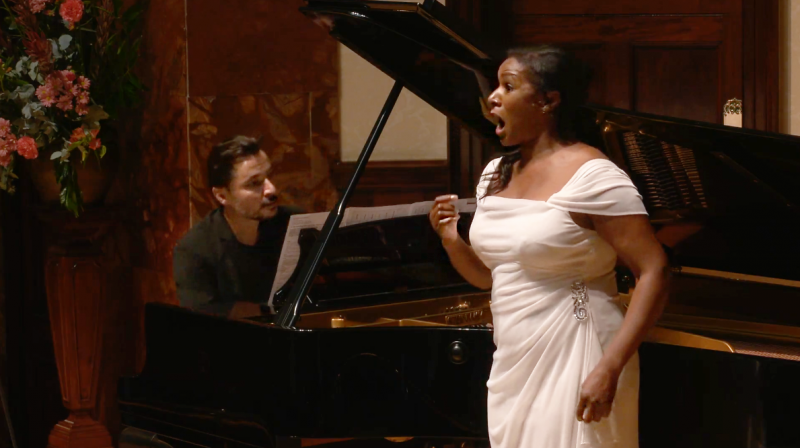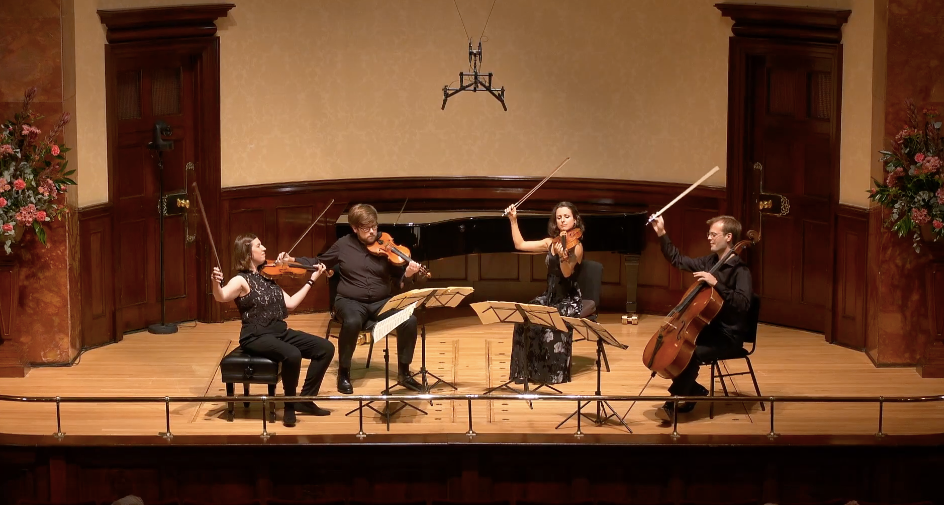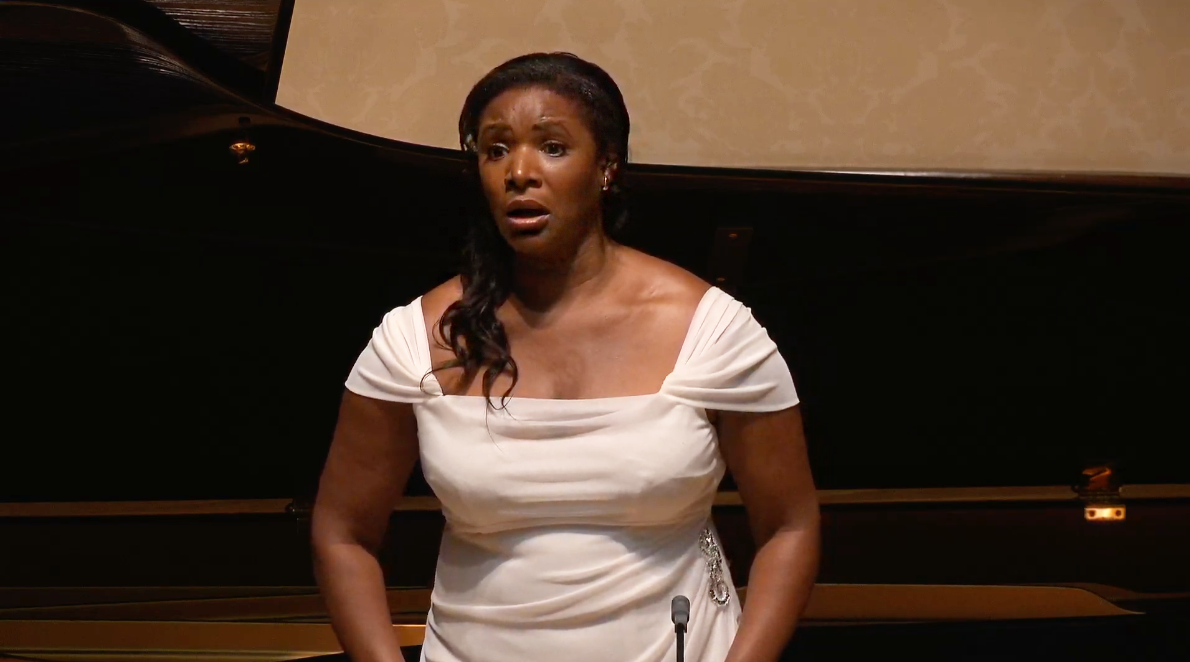Castalian Quartet/Elizabeth Llewellyn, Simon Lepper, Wigmore Hall review - out of this world | reviews, news & interviews
Castalian Quartet/Elizabeth Llewellyn, Simon Lepper, Wigmore Hall review - out of this world
Castalian Quartet/Elizabeth Llewellyn, Simon Lepper, Wigmore Hall review - out of this world
A young string quartet and a glorious duo take us from the earthy to the sublime

Songs of the beyond versus the profundity of the here and now struck very different depths in the Castalians’ evening concert at the Wigmore Hall and Elizabeth Llewellyn’s recital with equal partner Simon Lepper the following lunchtime. It was good to have the very human anchoring of Haydn’s “Emperor” Quartet, Op. 76 No.
The Castalians’ volatility was in marked contrast to the wise heads on young shoulders of the Hill Quartet in the last of the bandstand concerts. It would be impossible to prefer one over the other, but the tumbling vitality around the aristocratic elegance of what we now know as the German national anthem was especially welcome in twilight hour at the Wigmore. None of the players in any of the five quartets I’ve heard over the past month has been with his or her colleagues since lockdown in mid-March, so you can will believe the extra frisson of playing together – you read it especially in the face of the Castalians’ first violinist, the consummate Sini Simonen. But they needed to get very serious and focused in the “sacred song of thanks from a convalescent to the Godhead” that sits so strangely at the heart of Beethoven’s late masterpiece, and they did (pictured below: Simonen, Daniel Roberts, Charlotte Bonneton and·Christopher Graves).  At this point autobiography has to intrude: I find the “thanksgiving”, so different in its C major from the joy of Haydn, deeply disturbing. With the strings playing the sotto voce without vibrato for the most part on Wednesday evening, the molto adagio feels like cryogenic suspension, and the two leaping D major responses, “feeling new strength”, only temporarily displace it. You also have to ask what a movement like this is doing in the middle of so much A minor turbulence. The Castalians never let us off the hook for a moment in either mood – necessary hard work for an equally necessary live audience. Impressive, undoubtedly, but I don’t hear in any of it the “healing” mentioned in the presentation around the performance (many may like it, but I go to concerts partly to escape broadcasters' tendency to tell us how to respond to what we’ve heard).
At this point autobiography has to intrude: I find the “thanksgiving”, so different in its C major from the joy of Haydn, deeply disturbing. With the strings playing the sotto voce without vibrato for the most part on Wednesday evening, the molto adagio feels like cryogenic suspension, and the two leaping D major responses, “feeling new strength”, only temporarily displace it. You also have to ask what a movement like this is doing in the middle of so much A minor turbulence. The Castalians never let us off the hook for a moment in either mood – necessary hard work for an equally necessary live audience. Impressive, undoubtedly, but I don’t hear in any of it the “healing” mentioned in the presentation around the performance (many may like it, but I go to concerts partly to escape broadcasters' tendency to tell us how to respond to what we’ve heard).
Certainly we got the message about the magnificence of Llewelyn and Lepper the following lunchtime without the flagging-up by the presenter. It’s not easy to take an opulent operatic voice into the Wigmore – I well remember Karita Mattila overwhelming us – but Llewellyn, whom most of us have only experienced in Puccini and Verdi roles, proved herself a more than worthy recitalist. She still lives the world of each song like the stage animal she is – more sorrow than joy in Strauss, special rapture shot through with doubt in Mahler – but there’s unexpected refinement in white notes. That and the reining-in of a generous vibrato as well as a powerful chest voice reminded me somehow of Gwyneth Jones in her prime.  Samuel Coleridge-Taylor’s Six Sorrowful Songs sat between the Lieder masters. The Croydon-born mixed-race composer certainly deserves all the spotlight he's getting right now, but his chamber works are more original than these songs and inevitably there was less for Lepper to refine. Having delivered wonders especially in the dovetailings of Strauss's “Einerlei,” he merely had to keep any rodomontade at bay here, just as Llewellyn triumphed over any gaucheries in the Christina Rossetti texts, well set by Coleridge-Taylor, with absolute clarity of diction (that in itself makes Llewelyn an English National Opera artist in excelsis, though she should of course be singing at Covent Garden). Sorrow is a hard act to sustain in a whole group of songs, but the performers maintained sufficient variety; and while, in marked contrast to the brief opening song, the final “Too late for love” seemed like outstaying its welcome, the magical conclusion was worth waiting for.
Samuel Coleridge-Taylor’s Six Sorrowful Songs sat between the Lieder masters. The Croydon-born mixed-race composer certainly deserves all the spotlight he's getting right now, but his chamber works are more original than these songs and inevitably there was less for Lepper to refine. Having delivered wonders especially in the dovetailings of Strauss's “Einerlei,” he merely had to keep any rodomontade at bay here, just as Llewellyn triumphed over any gaucheries in the Christina Rossetti texts, well set by Coleridge-Taylor, with absolute clarity of diction (that in itself makes Llewelyn an English National Opera artist in excelsis, though she should of course be singing at Covent Garden). Sorrow is a hard act to sustain in a whole group of songs, but the performers maintained sufficient variety; and while, in marked contrast to the brief opening song, the final “Too late for love” seemed like outstaying its welcome, the magical conclusion was worth waiting for.
You wondered from looking at the programme if Llewellyn had aimed a bit too high with Mahler’s Rückert Lieder, begging comparison with the greats in this repertoire (the last one I heard singing them in the Wigmore was the Latvian mezzo Elīna Garanča, as classy as they come). Not at all: she lived each song again, with natural, believable gestures, brought out the white notes and the floated upper lines, unleashed the full operatic works on the biggest of the five settings, “Um Mitternacht” and retreated in perfect complicity with Lepper’s exquisite phrasing for what still has claim to being the most beautiful song ever, “Ich bin der Welt abhanden gekommen” (“I have become lost to the world”). Nor did the encore misfire: the light touch of Coleridge Taylor’s “Big Lady Moon”, with its mix of music-hall and spiritual, was sheer perfection. It seems clear that this partnership, having triumped in debut, has to become a regular one at the Wigmore.
- Watch these concerts free online for the next month on the Wigmore Hall website (log in to access): the Castalian Quartet here and Llewellyn/Lepper here
- More classical reviews on theartsdesk
rating
Explore topics
Share this article
The future of Arts Journalism
You can stop theartsdesk.com closing!
We urgently need financing to survive. Our fundraising drive has thus far raised £49,000 but we need to reach £100,000 or we will be forced to close. Please contribute here: https://gofund.me/c3f6033d
And if you can forward this information to anyone who might assist, we’d be grateful.

Subscribe to theartsdesk.com
Thank you for continuing to read our work on theartsdesk.com. For unlimited access to every article in its entirety, including our archive of more than 15,000 pieces, we're asking for £5 per month or £40 per year. We feel it's a very good deal, and hope you do too.
To take a subscription now simply click here.
And if you're looking for that extra gift for a friend or family member, why not treat them to a theartsdesk.com gift subscription?
more Classical music
 Hallé John Adams festival, Bridgewater Hall / RNCM, Manchester review - standing ovations for today's music
From 1980 to 2025 with the West Coast’s pied piper and his eager following
Hallé John Adams festival, Bridgewater Hall / RNCM, Manchester review - standing ovations for today's music
From 1980 to 2025 with the West Coast’s pied piper and his eager following
 Kaploukhii, Greenwich Chamber Orchestra, Cutts, St James's Piccadilly review - promising young pianist
A robust and assertive Beethoven concerto suggests a player to follow
Kaploukhii, Greenwich Chamber Orchestra, Cutts, St James's Piccadilly review - promising young pianist
A robust and assertive Beethoven concerto suggests a player to follow
 Robin Holloway: Music's Odyssey review - lessons in composition
Broad and idiosyncratic survey of classical music is insightful but slightly indigestible
Robin Holloway: Music's Odyssey review - lessons in composition
Broad and idiosyncratic survey of classical music is insightful but slightly indigestible
 Classical CDs: Wolf-pelts, clowns and social realism
British ballet scores, 19th century cello works and contemporary piano etudes
Classical CDs: Wolf-pelts, clowns and social realism
British ballet scores, 19th century cello works and contemporary piano etudes
 Bizet in 150th anniversary year: rich and rare French offerings from Palazzetto Bru Zane
Specialists in French romantic music unveil a treasure trove both live and on disc
Bizet in 150th anniversary year: rich and rare French offerings from Palazzetto Bru Zane
Specialists in French romantic music unveil a treasure trove both live and on disc
 Scottish Chamber Orchestra, Ibragimova, Queen’s Hall, Edinburgh review - rarities, novelties and drumrolls
A pity the SCO didn't pick a better showcase for a shining guest artist
Scottish Chamber Orchestra, Ibragimova, Queen’s Hall, Edinburgh review - rarities, novelties and drumrolls
A pity the SCO didn't pick a better showcase for a shining guest artist
 Kilsby, Parkes, Sinfonia of London, Wilson, Barbican review - string things zing and sing in expert hands
British masterpieces for strings plus other-worldly tenor and horn - and a muscular rarity
Kilsby, Parkes, Sinfonia of London, Wilson, Barbican review - string things zing and sing in expert hands
British masterpieces for strings plus other-worldly tenor and horn - and a muscular rarity
 From Historical to Hip-Hop, Classically Black Music Festival, Kings Place review - a cluster of impressive stars for the future
From quasi-Mozartian elegance to the gritty humour of a kitchen inspection
From Historical to Hip-Hop, Classically Black Music Festival, Kings Place review - a cluster of impressive stars for the future
From quasi-Mozartian elegance to the gritty humour of a kitchen inspection
 Shibe, LSO, Adès, Barbican review - gaudy and glorious new music alongside serene Sibelius
Adès’s passion makes persuasive case for the music he loves, both new and old
Shibe, LSO, Adès, Barbican review - gaudy and glorious new music alongside serene Sibelius
Adès’s passion makes persuasive case for the music he loves, both new and old
 Anja Mittermüller, Richard Fu, Wigmore Hall review - a glorious hall debut
The Austrian mezzo shines - at the age of 22
Anja Mittermüller, Richard Fu, Wigmore Hall review - a glorious hall debut
The Austrian mezzo shines - at the age of 22
 First Person: clarinettist Oliver Pashley on the new horizons of The Hermes Experiment's latest album
Compositions by members of this unusual quartet feature for the first time
First Person: clarinettist Oliver Pashley on the new horizons of The Hermes Experiment's latest album
Compositions by members of this unusual quartet feature for the first time

Add comment